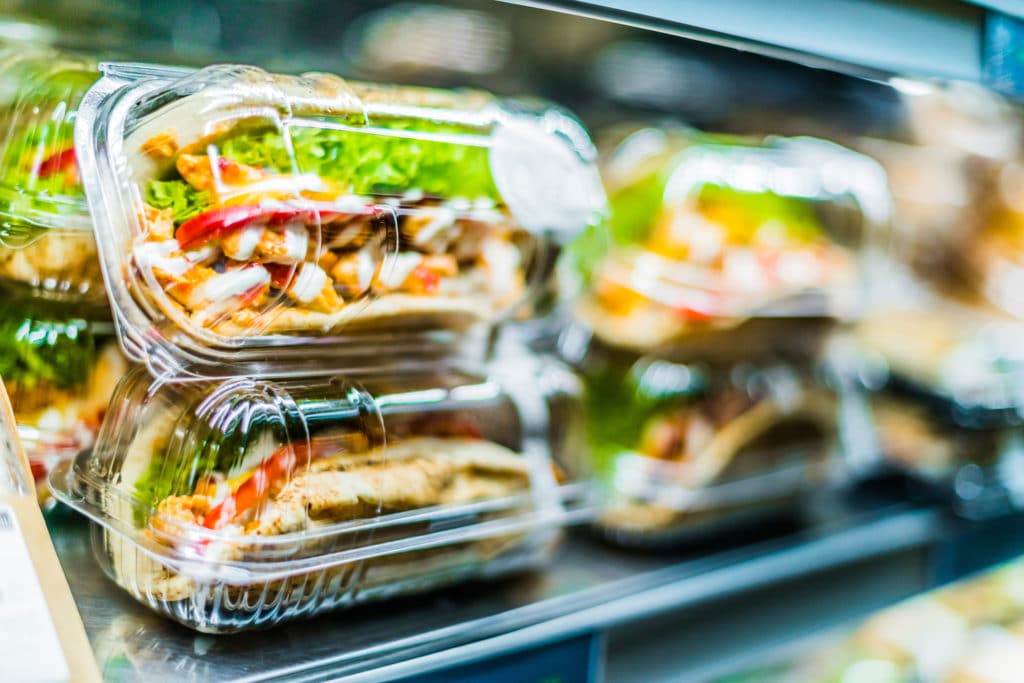Today, the available food production of France and the United States amounts to more than 3,500 calories per day per person – whereas needs are estimated at around 2,000–2,500 calories. But these figures are rarely quoted by those who fight against waste, whether they are industrialists, associations, or politicians.
Waste becomes a market
Marie Mourad studied the subject in France and the United States, and in her thesis highlighted this potentially negative effect of policies to reduce loss and waste. “In both countries, large-scale distribution and food industry firms, in conjunction with the Ministry of Agriculture in France and environmental associations in the United States, have produced estimates focusing on the percentages of products thrown away, sector by sector, without questioning either the quantities produced, or the nature of the food concerned. They thus promote a definition of waste as a problem of optimising existing production, distribution, and consumption, and favour the use of existing surpluses rather than their reduction at the source.”
As she shows, during the 2010s, competition developed between the different uses of surplus food. Seeking to use unsold food products, companies are strengthening the channels for donating consumable food to food aid associations, generating financial rewards (usually tax incentives) for donors.
Some sustainability managers of food companies are also setting up recycling and sales of non-consumable materials, in partnership with waste treatment companies. Founders of start-ups and associations are seizing the opportunity of these developments to develop intermediary activities that strengthen existing channels and create new channels for processing and reallocating surpluses. “These developments reveal a mechanism that could be described as the re-marketing of surpluses,” emphasises Marie Mourad. Their new market value is partly based, paradoxically, on their de-marketed (not sold) or non-marketed (not intended to be sold) character.
Another perverse effect of the fight against waste as it is currently organised is that tax deductions are most often calculated according to the weight of donated food, which encourages people to favour quantity over quality. For example, in the United States, but also in France, soda cans are treated as food: donating them is profitable for companies, even though it is harmful to the beneficiary populations, which are already suffering from malnutrition, overweight or obesity…
On the other hand, no measures are being taken to curb retailers’ ever more tempting offers of promotions that encourage consumption, on shelves that are generally much more visible and better presented than those where goods that are almost out of date are stocked and therefore offered at a lower cost.

Waste is multifactorial
Another problem in the fight against waste is the need – and the difficulty – of acting on several factors and/or actors at the same time. Barbara Redlingshöfer, a researcher at INRAE, has just completed a thesis on food loss and waste in cities and has studied public policies aimed at reducing food waste in the Paris region. She found that there are many public policies that offer levers for action, such as awareness-raising campaigns, tax incentives for food donations, and the sorting of bio-waste and its composting or methanisation.
These campaigns are part of policies related to food, waste, or energy, at various administrative levels. But they are not very well coordinated. For example, a “compost plan” is not coordinated with actions to combat waste and may even implicitly legitimise throwing away food by associating composting with a positive gesture.
Most food waste is currently treated by incineration, thanks to an efficient collection and treatment sector that needs to be fed… with waste! Although the legislative framework provides for the expansion of food waste collection and recycling, we are far from achieving the objectives. “We need to articulate and create synergies between these different policies instead of managing them in silos,” emphasises Barbara Redlingshöfer. “Otherwise, there is reason to fear that they will remain ineffective.”
The Territorial Food Projects (TFPs), which aim to relocate agriculture and food in the territories, should therefore take account of this type of interaction from the outset.
Individual differences
Furthermore, she emphasises the extent to which individual behaviour towards waste is diverse and complex and needs to be analysed at the level of households and their activities, and therefore beyond individuals. “There are of course individual sensitivities that are more or less receptive to this issue. But depending on the composition of the household, the occupation, the hobbies, the supply of shops in the neighbourhood, practices can differ.”
For example, contrary to popular belief, a large family wastes less per person than a couple without children, because they have more opportunities to offer cooked leftovers. Another example is that, depending on whether people have time to go shopping during the day or not, they may fill their fridge as closely as possible to their needs, or on the contrary, they may stock up, some of which may end up in the bin. It will be important to analyse how the development of teleworking will affect waste.
It can be assumed that it is easier for a person who works from home to do the daily shopping than for someone who has an hour’s commute to the office. Also, aspirations to eat “healthily” may conflict with wanting to waste less, as eating “healthily” is often associated with eating produce, particularly fruit and vegetables, as fresh as possible.
“This field of research on household food practices and their determinants is recent, but when we see the multiplicity of interacting factors, we already know that we will have to find different levers of action, and not think in silos as we tend to do today, targeting each category – consumers, distributors, producers – separately,” concludes Barbara Redlingshöfer.
Awareness-raising projects are underway
“There is some good news, however: awareness of waste is growing and the mobilisation for ‘ugly’ products, for example, is bearing fruit,” emphasises Marie Mourad.
On the issue of use-by dates, Too Good to Go has made real progress by having 62 companies sign a pact to reduce food waste due to use-by dates. Thus, 3,000 product ranges raise consumer awareness of the Minimum Durability Dates (MDD) with “Observe, smell, taste” pictograms to encourage them to use their senses, and more than 600 anti-waste shelves have been deployed to sell products with a close or exceeded MDD. Proof that it is possible to get around certain regulatory obstacles.
Finally, some advice given to households, if followed, has proven effective: such as making shopping lists before going to the shop avoids impulse buying, measuring out the quantities to be cooked according to needs and learning to cook with leftovers prevents the bins from filling up too quickly. One example is that of Great Britain, which carried out real work in the field, mobilising local players as close as possible to families, organising cooking workshops and training to strengthen their ability to manage their food better.
In France, associations such as Familles rurales carry out equivalent actions throughout the country, as close as possible to the households.









